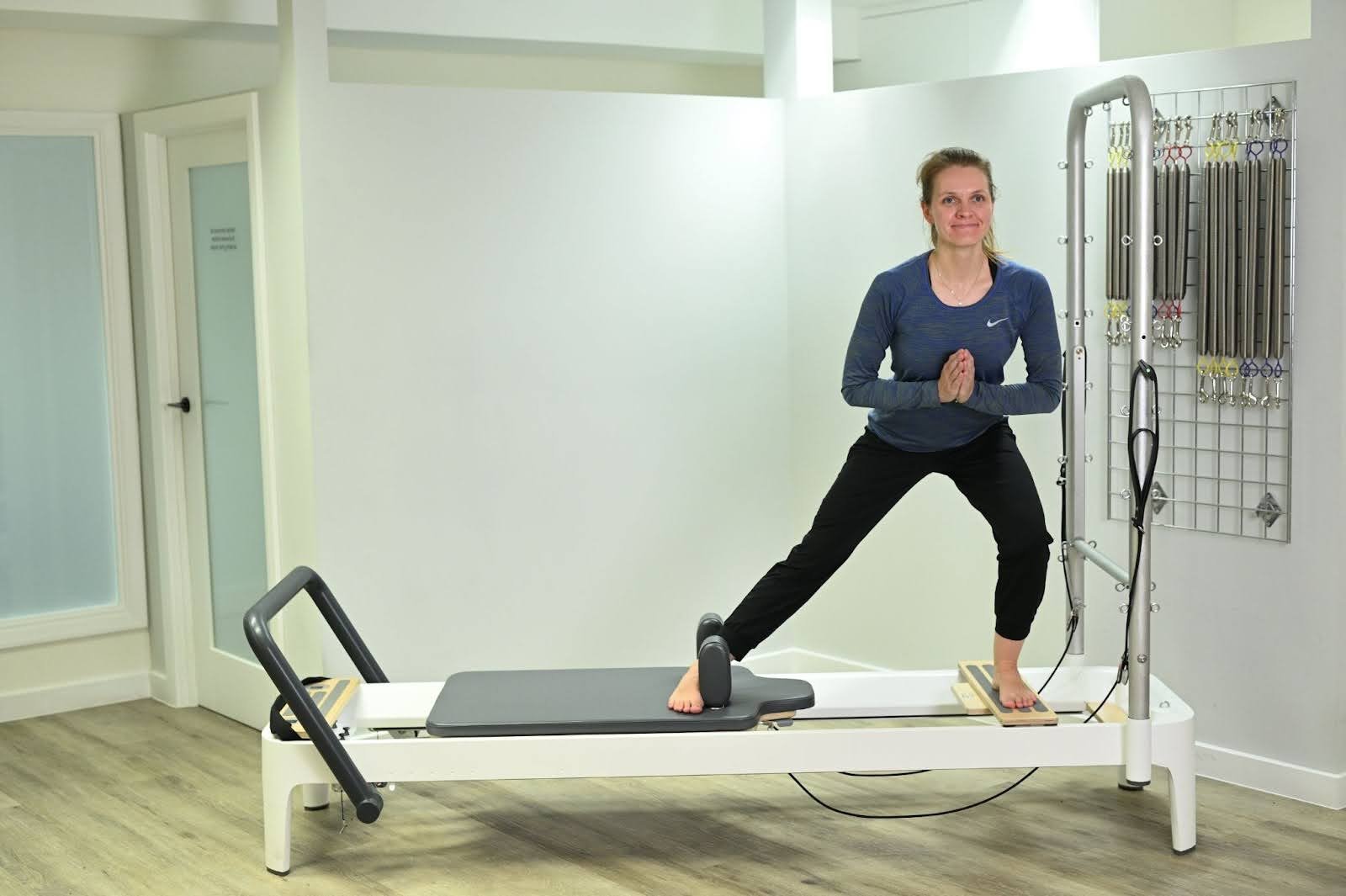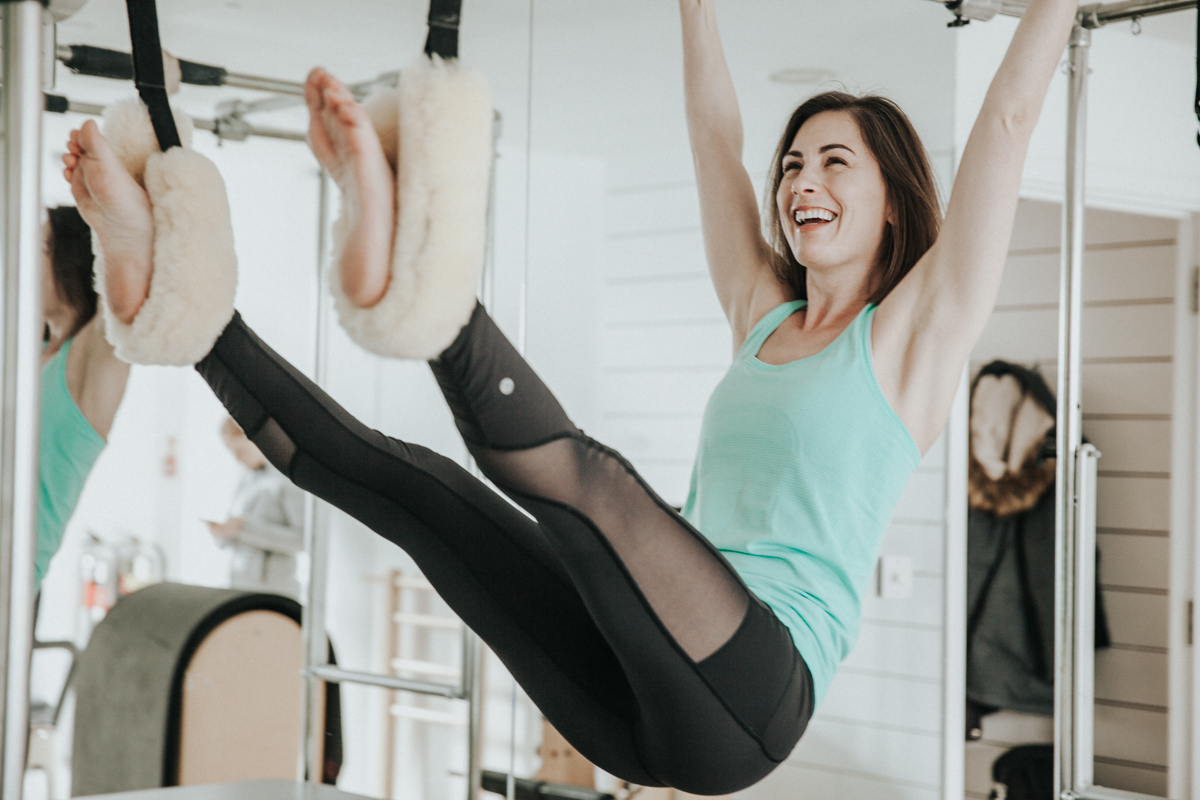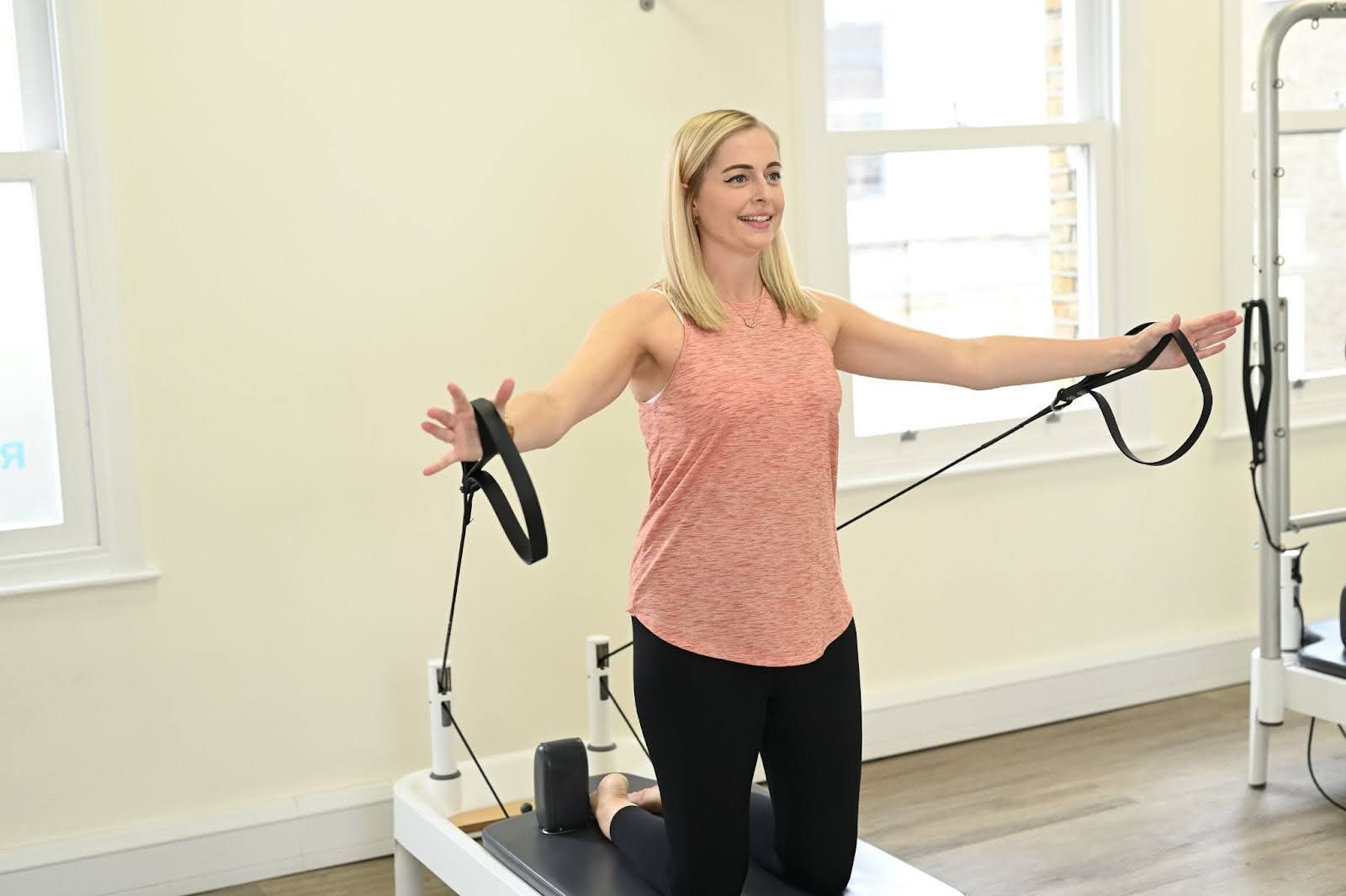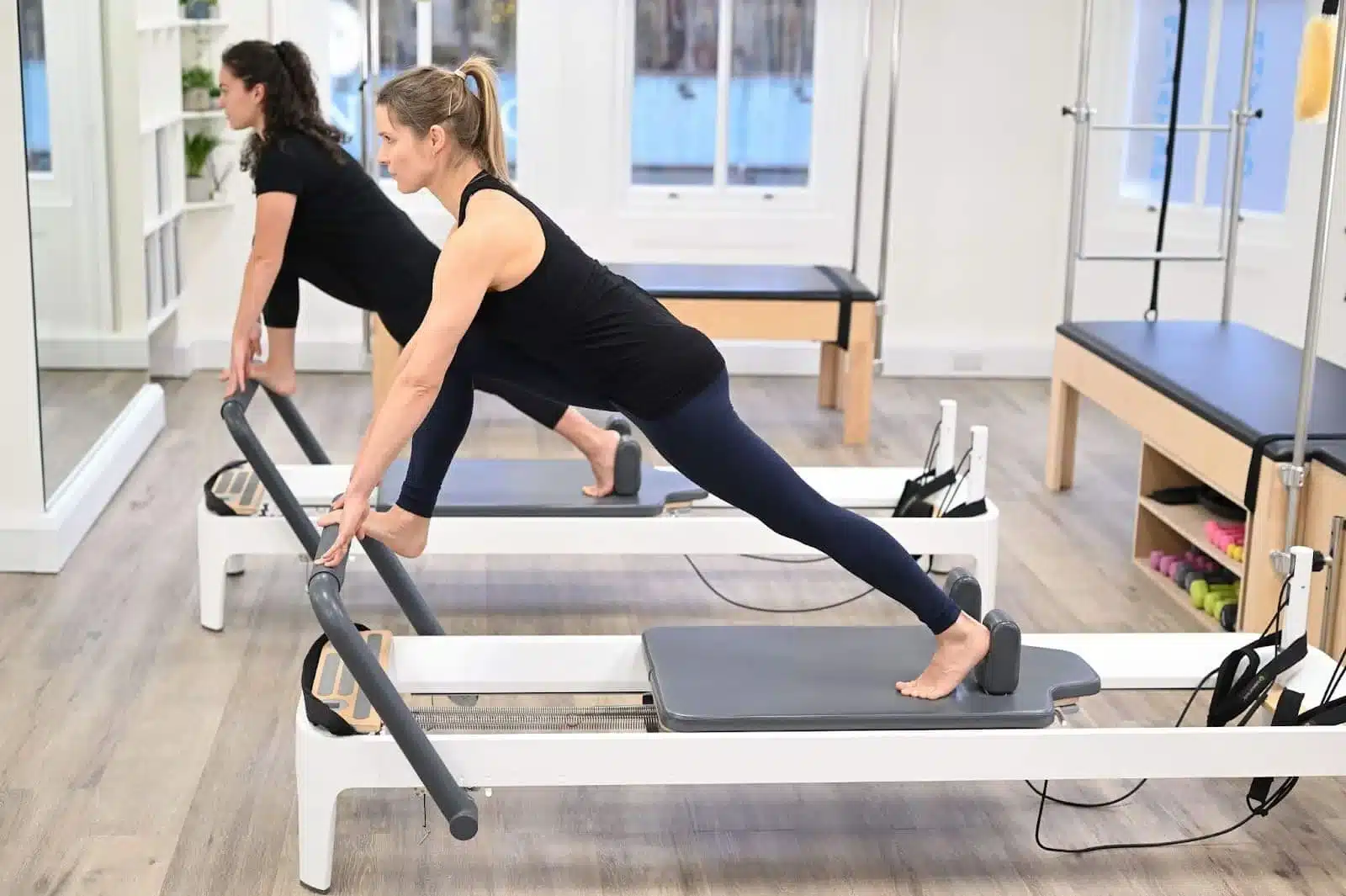Key Contributor: Isabelle Bay, Chartered Physiotherapist
Pilates has evolved over the last century from its traditional inception as “Contrology”, founded by Joseph Pilates, to a global phenomenon with classes utilising all Pilates apparatus, including the Reformer.
There have been many iterations of Pilates, including a contemporary style of Reformer group class known as Dynamic reformer Pilates.
Dynamic reformer Pilates may draw on some or all of the key guiding principles of Pilates. These include breath, concentration, control, precision, centre, and flow. You can find out more on the principles of pilates here.
Dynamic reformer Pilates also draws on modern strength and conditioning training methods and can include use of other exercise equipment – for example, free weights.
In summary, Dynamic reformer Pilates is a type of Pilates class that combines the Pilates principles with elements of strength and conditioning – all performed on the Reformer machine.
Key Takeaways
- Dynamic reformer Pilates is a contemporary form of Pilates that utilises the foundational Pilates principles combined with modern strength and conditioning training methods
- Dynamic reformer Pilates varies from traditional reformer classes in terms of exercise selection, dosage, sequence, and pace
- Dynamic reformer Pilates varies may be more suitable for advanced movers or people experienced with reformer classes
What’s the difference between dynamic reformer Pilates and regular reformer Pilates?
Regular reformer Pilates can also be referred to as “contemporary reformer Pilates”. Within the contemporary reformer Pilates exercise repertoire, there are “classical” reformer Pilates exercises which come from the original holistic exercise system created by Joseph Pilates with aims “to elongate, strength and restore the body to balance” (Pilates Foundation, n.d.).
Whilst there can be contemporary variations of the classical reformer Pilates exercises, for the purpose of this article we will look at the comparison between classical reformer Pilates and dynamic reformer Pilates.
On the one hand, classical reformer Pilates and dynamic reformer Pilates hold a similar emphasis for developing core stability and strength, but on the other hand there are key differences in the way these forms of Pilates are conducted.
| Reformer Pilates | Dynamic Reformer Pilates | |
|---|---|---|
| Exercise selection | Specific exercises from the original classical system
May incorporate contemporary variations of classical exercises Focus on unilateral and isolation, as well as compound movements Focus on full body integration and creating efficient movement patterns Focus on the mind-body connection |
May incorporate exercises from the original classical repertoire in addition to movements typically used in a strength training setting e.g. squats
Focus on compound movements Often focuses on getting sweaty and working hard May include use of jumpboard for plyometric work |
| Duration per exercise | Typically longer due to working on technique of the classical repertoire | Typically shorter due to the faster pace of the class and quicker transitions between different exercises |
| Structure | Typically will start on the Reformer lying on your back, and will follow a specific classical order of exercises | May start in any position on the Reformer, and could go anywhere from there!
May spend a significant proportion of class kneeling or standing on the Reformer challenging stability and balance |
| Sets | Single set | May incorporate multiple sets e.g. supersets or circuit challenges |
| Load or resistance | Specific resistance range for each exercise, however due to individual differences this may vary | May replicate the classical resistance range for a given exercise, or may be substantially increased or decreased depending on the purpose of the exercise
May also incorporate additional resistance such as dumbbells |
| Pace | Slower pace to focus on technique | Faster pace, less recovery time |
Who are Dynamic reformer Pilates classes for?
Dynamic reformer classes are suitable for:
- People who are experienced in reformer Pilates and would like to add challenge and diversity into their training.
- People who find Classical reformer Pilates too slow-paced for them.
Dynamic reformer classes are not suitable for:
- Those new to reformer Pilates.
- Those recovering from injury or illness.
- Pregnant clients due to the higher intensity, unpredictability of class format, and stability challenge with standing on the reformer (unless it is a pregnancy class with a qualified pregnancy instructor).
What to Expect in a Dynamic Reformer Pilates Class
- A dynamic reformer Pilates class is an exciting endeavour! Unlike a classical reformer Pilates class where you will typically start positioned on your back on the reformer for a warm up, in a dynamic class there are endless opportunities where you could commence the workout.
- Generally it will incorporate an element of core activation and spine mobility to warm up the body, and then the world is your oyster.
- From there you will typically flow around the reformer machine with quick transitions between exercise series’, meaning less rest time and higher intensity. Whilst the speed of exercise is typically still performed at a slow tempo, the fast transitions between exercise sets keeps the pace of the class intense!
- The class may increase the intensity of challenge by using equipment such as the jumpboard for plyometrics and free weights, or by alternating between two exercises at a rapid pace which can help to increase the heart rate.
- You will likely finish the class with a relaxing cool down and focus on mobilising the areas worked to ensure muscle recovery.
- The feel of a dynamic reformer class is generally one of surprise and excitement with the large number of exercises to be chosen and varied structure.
Benefits of Dynamic Reformer Pilates
Physical
Improvements in strength, stability, mobility, balance, movement control, and coordination.
Mental
Improved mind-body connection to prep the body for other forms of exercise e.g. in the gym setting. A sense of accomplishment from completing a challenging workout.
Is Dynamic Reformer Pilates Hard?
Yes! For most people dynamic reformer Pilates is a challenging workout, with each class being entirely different it requires a unique combination of strength, stability, mobility, balance, movement control, and coordination.
How Often Should I Do It?
Both dynamic and classical reformer Pilates are forms of strength training and are therefore recommended to be completed 2-3x/week.
FAQs
Can beginners do Dynamic Reformer Pilates?
For safety reasons, it is not recommended that beginners undertake dynamic reformer. There are plenty of beginner classes on offer where the foundation movements can be learned.
People who are beginners to Pilates should generally start with 1:1 so they get an understanding of the principles and proper technique as well as how to use the equipment safely. This is even more important for those recovering from injury or illness, or are pre or post natal.
How is it different from HIIT or the gym?
Depending on how the class is designed, dynamic reformer Pilates can incorporate intervals within the class structure utilising the reformer as a form of resistance. However as the class tends to last for 45-60 minutes, and due to the varying loads required for someone to achieve the heart rate for high intensity, the majority of the class is performed at a low-moderate intensity.
The reformer machine is different from the equipment used at the gym and free weights because it uses spring tension. More on what the differences are between free weights and springs can be found here.
Whilst dynamic reformer Pilates may incorporate the use of free weights, this is in addition to the tension created through the springs of the machine, which creates a substantial challenge for the key stabilisers of the body. The free weights are also often lighter load than those you might use in the gym. This is because in reformer classes you tend to do more repetitions.
I’m already doing Pilates – should I do Dynamic Reformer Pilates?
Yes! It is a fantastic way to challenge yourself by adding intensity to your Pilates practice, alongside numerous other benefits including enhanced strength, stability, balance, mobility, movement control, and coordination.
Conclusion
Dynamic reformer Pilates blends classical control with modern strength training, and is appropriate for advanced movers or those experienced with reformer classes. Whilst it shares the foundational Pilates principles with classical reformer Pilates, they differ in terms of exercise selection, dosage, sequence, and pace.
If you are feeling inspired and would like to learn reformer Pilates, come and try PIlates at Complete. We specialise in 1:1 Pilates using all Pilates equipment, including the Reformer and we are the best place to start your reformer journey.
Resources
Pilates Foundation (n.d.) https://www.pilatesfoundation.com/about-pilates
Feeling inspired?
If you want to experience the Complete difference and discover the benefits of one-to-one Pilates, book a session at one of our London studios or online today.
Our physiotherapist-led Pilates studios in Chelsea, our Angel Pilates studio and our Pilates studio in City, offer a highly tailored approach to your Pilates training, whether your goal is to manage a health condition, rehabilitate from an injury or to improve your strength and fitness.
Get in touch with us via email or contact us on 0203 764 5668 for further information.
Education is key:
These blogs are designed to give information to everyone, however, it is important to remember that everyone is different! If you have not seen one of our therapists and have any questions about injuries, what you have read or whether this may be useful to you, please just ask. We are more than happy to help anyone and point you in the right direction. Our biggest belief is that education is key. The more you understand about your injury, illness and movement, the more you are likely to improve.






